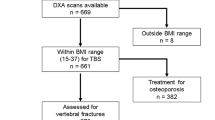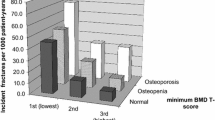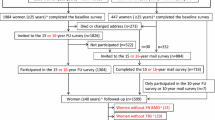Abstract
Introduction
Trabecular bone score (TBS) is partially independent of fracture risk. Reference values for TBS have not been established in official guidelines, and thus clinicians often have difficulty interpreting TBS results. This study aimed to investigate whether reference values for TBS could be a valid indicator for clinical vertebral fracture (CVF).
Materials and methods
This cross-sectional study involved 231 women with CVF and 563 women without CVF aged 60–90 years who underwent dual-energy X-ray absorptiometry during 2019–2023. They were divided into osteoporosis, osteopenia, and normal groups according to bone mineral density of the lumbar spine. Reference values for TBS were defined as low (≤ 1.23), intermediate (1.23–1.31), and high (≥ 1.31).
Results
Among patients without anti-osteoporosis treatment (n = 476), the proportion with low TBS was 36.7% in the CVF group and 10.7% in the control group. The proportion with CVF was higher in the low TBS group than in the intermediate and high TBS groups, especially in the osteoporosis group (p < 0.001). The odds ratio for CVF was higher in the low TBS group than in the intermediate and high especially in patients with normal BMD and osteoporosis. The TBS cut-off values for incidence of CVF in the osteoporosis, osteopenia, and normal groups were 1.224, 1.319, and 1.322, respectively.
Conclusions
The reference value for low TBS (≤ 1.23) was useful as an indicator for CVF, especially in patients with osteoporosis. It is expected that reference values for TBS will be established in official guidelines in the future.



Similar content being viewed by others
Abbreviations
- AUC:
-
Area under the curve
- BMD:
-
Bone mineral density
- BMI:
-
Body mass index
- CVF:
-
Clinical vertebral fracture
- DXA:
-
Dual-energy X-ray absorptiometry
- FRAX:
-
Fracture Risk Assessment Tool
- ICC:
-
Intraclass correlation coefficient
- ISCD:
-
International Society for Clinical Densitometry
- SD:
-
Standard deviation
- SERM:
-
Selective estrogen receptor modulator
- TBS:
-
Trabecular bone score
- WHO:
-
World Health Organization
References
(2001) Osteoporosis prevention, diagnosis, and therapy. Jama 285:785–795
Brown JP, Engelke K, Keaveny TM, Chines A, Chapurlat R, Foldes AJ, Nogues X, Civitelli R, De Villiers T, Massari F, Zerbini CAF, Wang Z, Oates MK, Recknor C, Libanati C (2021) Romosozumab improves lumbar spine bone mass and bone strength parameters relative to alendronate in postmenopausal women: results from the Active-Controlled Fracture Study in Postmenopausal Women With Osteoporosis at High Risk (ARCH) trial. J Bone Miner Res 36:2139–2152
Kanis JA (1994) Assessment of fracture risk and its application to screening for postmenopausal osteoporosis: synopsis of a WHO report. WHO Study Group Osteoporos Int 4:368–381
Johnell O, Kanis JA, Oden A, Johansson H, De Laet C, Delmas P, Eisman JA, Fujiwara S, Kroger H, Mellstrom D, Meunier PJ, Melton LJ 3rd, O’Neill T, Pols H, Reeve J, Silman A, Tenenhouse A (2005) Predictive value of BMD for hip and other fractures. J Bone Miner Res 20:1185–1194
Kadri A, Binkley N, Daffner SD, Anderson PA (2023) Fracture in patients with normal bone mineral density: an evaluation of the american orthopaedic association’s own the bone registry. J Bone Joint Surg Am 105:128–136
Hans D, Goertzen AL, Krieg MA, Leslie WD (2011) Bone microarchitecture assessed by TBS predicts osteoporotic fractures independent of bone density: the Manitoba study. J Bone Miner Res 26:2762–2769
Richards C, Leslie WD (2022) Trabecular Bone Score in Rheumatic Disease. Curr Rheumatol Rep 24:81–87
Silva BC, Leslie WD, Resch H, Lamy O, Lesnyak O, Binkley N, McCloskey EV, Kanis JA, Bilezikian JP (2014) Trabecular bone score: a noninvasive analytical method based upon the DXA image. J Bone Miner Res 29:518–530
Cozadd AJ, Schroder LK, Switzer JA (2021) Fracture Risk Assessment: An Update. J Bone Joint Surg Am 103:1238–1246
Cianferotti L, Cipriani C, Corbetta S, Corona G, Defeudis G, Lania AG, Messina C, Napoli N, Mazziotti G (2023) Bone quality in endocrine diseases: determinants and clinical relevance. J Endocrinol Invest
Shevroja E, Cafarelli FP, Guglielmi G, Hans D (2021) DXA parameters, Trabecular Bone Score (TBS) and Bone Mineral Density (BMD), in fracture risk prediction in endocrine-mediated secondary osteoporosis. Endocrine 74:20–28
Fujimaki H, Tomioka M, Kanoshima Y, Morita A, Yamori T, Inaba Y (2022) Accuracy of the Fracture Risk Assessment Tool for judging pharmacotherapy initiation for primary osteoporosis. J Bone Miner Metab 40:860–868
Silva BC, Broy SB, Boutroy S, Schousboe JT, Shepherd JA, Leslie WD (2015) Fracture Risk Prediction by Non-BMD DXA Measures: the 2015 ISCD Official Positions Part 2: Trabecular Bone Score. J Clin Densitom 18:309–330
Leslie WD, Shevroja E, Johansson H, McCloskey EV, Harvey NC, Kanis JA, Hans D (2018) Risk-equivalent T-score adjustment for using lumbar spine trabecular bone score (TBS): the Manitoba BMD registry. Osteoporos Int 29:751–758
Camacho PM, Petak SM, Binkley N, Diab DL, Eldeiry LS, Farooki A, Harris ST, Hurley DL, Kelly J, Lewiecki EM, Pessah-Pollack R, McClung M, Wimalawansa SJ, Watts NB (2020) American Association Of Clinical Endocrinologists/American College Of Endocrinology Clinical Practice guidelines for the diagnosis and treatment of postmenopausal osteoporosis-2020 update. Endocr Pract 26:1–46
McCloskey EV, Odén A, Harvey NC, Leslie WD, Hans D et al (2016) A Meta-Analysis of Trabecular Bone Score in Fracture Risk Prediction and Its Relationship to FRAX. J Bone Miner Res 31:940–948
Goel H, Binkley N, Hans D, Leslie WD (2023) Bone density and trabecular bone score to predict fractures in adults aged 20–39 years: a registry-based study. Osteoporos Int
Khan MA, Jennings JW, Baker JC, Smolock AR, Shah LM et al (2023) ACR Appropriateness Criteria® Management of Vertebral Compression Fractures: 2022 Update. J Am Coll Radiol 20:S102-s124
Genant HK, Wu CY, van Kuijk C, Nevitt MC (1993) Vertebral fracture assessment using a semiquantitative technique. J Bone Miner Res 8:1137–1148
Shuhart CR, Yeap SS, Anderson PA, Jankowski LG, Lewiecki EM, Morse LR, Rosen HN, Weber DR, Zemel BS, Shepherd JA (2019) Executive Summary of the 2019 ISCD Position Development Conference on Monitoring Treatment, DXA Cross-calibration and Least Significant Change, Spinal Cord Injury, Peri-prosthetic and Orthopedic Bone Health, Transgender Medicine, and Pediatrics. J Clin Densitom 22:453–471
Borgen TT, Bjørnerem Å, Solberg LB, Andreasen C, Brunborg C et al (2019) High prevalence of vertebral fractures and low trabecular bone score in patients with fragility fractures: A cross-sectional sub-study of NoFRACT. Bone 122:14–21
Fluss R, Faraggi D, Reiser B (2005) Estimation of the Youden Index and its associated cutoff point. Biom J 47:458–472
Agarwal K, Cherian KE, Kapoor N, Paul TV (2022) OSTA as a screening tool to predict osteoporosis in Indian postmenopausal women - a nationwide study. Arch Osteoporos 17:121
Kuriakose C, Cherian KE, Jebasingh F, Kapoor N, Asha HS, Jose A, Thomas N, Paul TV (2022) The prevalence of vertebral fractures among Indian perimenopausal women and its association with ovarian biomarkers. J Bone Miner Metab 40:142–149
Vinolas H, Grouthier V, Mehsen-Cetre N, Boisson A, Winzenrieth R, Schaeverbeke T, Mesguich C, Bordenave L, Tabarin A (2018) Assessment of vertebral microarchitecture in overt and mild Cushing’s syndrome using trabecular bone score. Clin Endocrinol (Oxf) 89:148–154
Pothuaud L, Carceller P, Hans D (2008) Correlations between grey-level variations in 2D projection images (TBS) and 3D microarchitecture: applications in the study of human trabecular bone microarchitecture. Bone 42:775–787
Palomo T, Muszkat P, Weiler FG, Dreyer P, Brandão CMA, Silva BC (2022) Update on trabecular bone score. Arch Endocrinol Metab 66:694–706
Kužma M, Hans D, Koller T, Némethová E, Jackuliak P, Killinger Z, Resch H, Payer J (2018) Less strict intervention thresholds for the FRAX and TBS-adjusted FRAX predict clinical fractures in osteopenic postmenopausal women with no prior fractures. J Bone Miner Metab 36:580–588
Goel H, Binkley N, Hans D, Leslie WD (2023) Fracture risk gradient assessed by categories of bone mineral density and trabecular bone score: the Manitoba BMD Registry. Arch Osteoporos 18:73
Iki M, Tamaki J, Kadowaki E, Sato Y, Dongmei N, Winzenrieth R, Kagamimori S, Kagawa Y, Yoneshima H (2014) Trabecular bone score (TBS) predicts vertebral fractures in Japanese women over 10 years independently of bone density and prevalent vertebral deformity: the Japanese Population-Based Osteoporosis (JPOS) cohort study. J Bone Miner Res 29:399–407
Popp AW, Meer S, Krieg MA, Perrelet R, Hans D, Lippuner K (2016) Bone mineral density (BMD) and vertebral trabecular bone score (TBS) for the identification of elderly women at high risk for fracture: the SEMOF cohort study. Eur Spine J 25:3432–3438
Acknowledgements
This research received no specific grant from any funding agency in the public, commercial, or not-for-profit sectors.
Author information
Authors and Affiliations
Contributions
YO: conceptualization, data curation, formal analysis, writing – original draft. NM: data curation. KW: formal analysis. RO: data curation. YT: data curation. DH: data curation. TG: formal analysis. MM: conceptualization. TE: data curation. HH: data curation. KS: conceptualization, supervision. All authors have reviewed and approved the final manuscript.
Corresponding author
Ethics declarations
Conflicts of interest
All authors declare have no conflicts of interest.
Informed consent
Informed consent was obtained from all individual participants included in the study.
Additional information
Publisher's Note
Springer Nature remains neutral with regard to jurisdictional claims in published maps and institutional affiliations.
About this article
Cite this article
Omichi, Y., Mima, N., Wada, K. et al. Can TBS reference values be a valid indicator for clinical vertebral fracture? A cross-sectional study. J Bone Miner Metab 42, 60–68 (2024). https://doi.org/10.1007/s00774-023-01476-1
Received:
Accepted:
Published:
Issue Date:
DOI: https://doi.org/10.1007/s00774-023-01476-1




